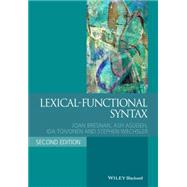- Provides both an introduction to LFG and a synthesis of major theoretical developments in lexical-functional syntax over the past few decades
- Includes in-depth discussions of a large number of syntactic phenomena from typologically diverse languages
- Features extensive problem sets and solutions in each chapter to aid in self-study
- Incorporates reader feedback from the 1st Edition to correct errors and enhance clarity








